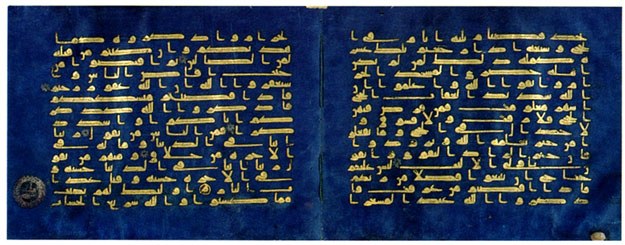

A North African Qur'an, 900s, in kufic script on deep blue vellum
Source: http://www.islamicart.com/main/calligraphy/catalog/index.htm
(downloaded April 2000)
"Probably North Africa, 10th century. Double page from the Holy Qur'an. Gouache and gold on vellum. Each page 11 l/2 x 15 3/4. in. Riyadh, Rifaat Sheikh El-Ard collection.
These pages come from one of the best known copies of the Qur'an in Kufic script. The script is gold, written along fifteen guidelines impressed on the vellum with a sharp point. Prior to the text having been written, the vellum was stained blue, probably with indigo. The manuscript was clearly produced for a special occasion, as the use of blue vellum was not at all common. However, the occasion remains as yet unknown.
Each verse is indicated by a small silver rosette, now tarnished and hardly distinguishable. The text consists of Surah II, Al-Baqarah, The Cow, verses 197-201. The end of verse 200 is marked with a golden circle bearing the Arabic letter dal and also with a silver medallion in the lower left-hand margin. The letters of the Arabic alphabet had a numerical as well as a linguistic function in early times. Therefore the encircled letters occurring throughout this text appear to have been used for the purpose of numbing some of the verses. Although most of the manuscript was originally in Qayrawan, Tunisia, several folios are found in collections elsewhere. The folios shown here are unusual in that they are conjugate, indicating that they came from the center of a quire located in the first section of the Qur'an. There has been much speculation on the origin of this Qur'an, but it is now accepted as North African. According to a 13th century inventory of the manuscripts in the Mosque of Qayrawan published some years ago, there was a copy of the Qur'an on blue vellum which was probably the manuscript from which these pages came."

A Kufic Qur'an leaf on vellum, 10th century
Source: http://search.sothebys.com/jsps/live/lot/LotDetail.jsp?lot_id=4DV87
(downloaded Mar. 2005)
" LARGE QUR'AN LEAF IN KUFIC SCRIPT ON VELLUM, NORTH AFRICA OR NEAR EAST, 10TH CENTURY. Measurements note: 20.8 by 33cm.
DESCRIPTION: text: sura lxii, al-jum'ah, vv.1-5. 5 lines per page written in fine, kufic script in brown ink on vellum, no diacritics, vocalisation in red, green, blue and yellow dots, single verses marked with gold roundels surrounded by petals in brown ink and containing exact verse number, sura heading in bold kufic in gold on a rectangular panel of gold with a scrolling foliate motif outlined in brown ink, palmette originally extending into margin, trimmed to text and across palmette.
CATALOGUE NOTE: This leaf comes from a Qur'an with a very distinctive script, examples of which are very rarely seen on the market. The only other leaves from this Qur'an to have appeared at auction were sold in these rooms 23 April 1979, lot 9 (a pair), 8 July 1980, lot 157 (single leaf with sura heading), 29 April 1998, lots 10 and 11, and lots 30 and 31, 12 October 2000.
The script is notable not only for its elegance but also for several other distinguishing features, such as the extended vertical letters, the wide, curving terminal nun, and the occasional slender curving tail of the terminal mim. This set of features only occur on two other known copies of the Qur'an. Leaves from the first can be found in the Al-Sabah Collection, Kuwait (Dodds 1992, fig.1, p.117), the Tareq Rajab Museum, Kuwait, and the Nasser D. Khalili Collection, London (Déroche 1992, no.58). While leaves from the second are in the National Library, Tunis (Rutbi 52, Lings and Safadi, no.24) and the Musée des art Islamique, Qairawan (Carthage, no.358).
A further unusual feature of the script is the manner in which the vertical parts of the letters ta and za and terminal kaf curve forwards. This feature is most commonly associated with eastern kufic script, as is the extended vertical and the playful confrontation of the lam alif in the word la also in evidence here. The eastern kufic script was present in the Muslim west towards the close of the tenth century A.D. and the present leaf may be an early example of the spread of this script westwards across the Islamic world.
The present leaf is also notable for the detailed attention to each verse ending which is marked by a stylised rosette of considerable size containing an exact number, as well as its lavishly illuminated and bold sura heading. Of the other known leaves from this Qur'an only two show sura headings, each with similar large gold panels and confident inscriptions (see Islamische Buchkunst 1980, p.54, no.35 and Sotheby's London 8 July 1980, lot 157 later published in Fehervari & Safadi 1981, p.28, no.1)."